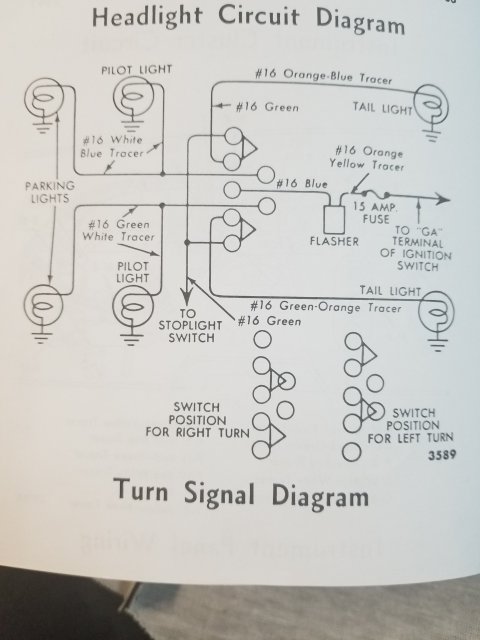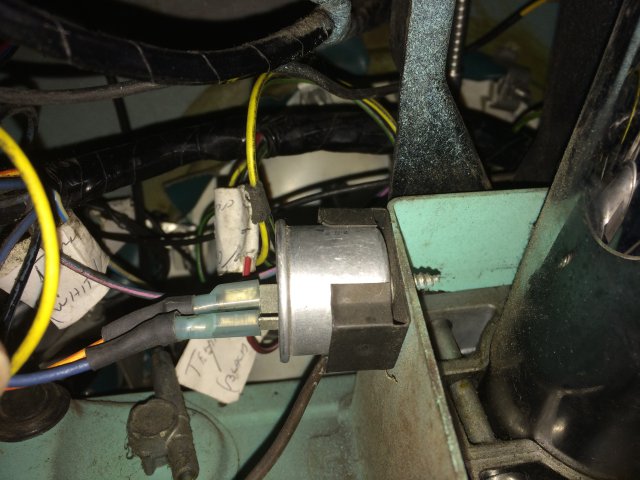- Last seen
- Joined
- Mar 12, 2021
- Thunderbird Year
- 1956
Follow along with the video below to see how to install our site as a web app on your home screen.

Note: This feature currently requires accessing the site using the built-in Safari browser.

Please
sign in or
join the Thunderbird
club free to access the search page and many other free site features.
If you forgot your password
click here
This site contains affiliate links for which I may be compensated. As an eBay Partner, and Amazon Associate I may be compensated if you make a purchase at no cost to you.

I should specify when wrote switch it is the signal or directional switch. Not the ignition switchThe switch could also be the problem, if you hold up or down on the switch, will it continue flashing. See the attached diagram.
Voltage comes from the battery through the fuse to the flasher, then passes on through the switch to the lights.
Yes, grounding is completed at the light bulb, which would only affect the bulbs.
I removed my switch for cleaning and reassembly was a pain. Only slightly better, new switch cured my issue.
I also put a new flasher in and im thinking they are polarity sensitive. But I can't be sure.
View attachment 17278
Jeff,There are only 2 terminals with individual wires. One hot and one hot when lever is moved up or down. I did try to ground the flasher case to unpainted bolt. No difference, just one click.

DougJeff,
You said that on the flasher relay one terminal has power and the other terminal only has power when the turn signal lever is moved out of the neutral position, if that is true you have a defective flasher relay.
Looking at the wiring diagram, available voltage from the ignition switch goes through the orange wire with the yellow tracer, through the 15 amp fuse to the terminal on the flasher relay. So that terminal has available voltage when the ignition switch is turned on. Since the flasher relay is a switch and when current is not flowing through it, the flasher relay is closed and available voltage should be at both terminals of the flasher relay. Since you said that on your flasher relay only one terminal has power that would indicate that you have a defective flasher relay. In other words, when the ignition switch is on and the turn signal switch is in the neutral position, you should have available voltage at both terminals of the flasher relay, both the one with the orange wire with the yellow tracer and the one with the blue wire.
Before you start going down the rabbit hole replacing the turn signal switch and its wiring, remove the flasher relay and bypass it by connecting the two wires together. If the flasher relay is defective, when you move the turn signal lever to the left or right positions the respective turn signal lights will illuminate and remain on.
doug7740
1955 Thunderbird Blue
Consider the parts involved…the turn signal switch in the column, the flasher, the fuse and finally the individual bulbs, sockets and wiring. I would begin by checking the fuse using my favorite basic test tool (a test light) to confirm power is going though the line and the fuse is good. Then find the flasher and using the test light confirm power at the flasher when the turn signal is cycled for both left and right. So now you have traced power through the fuse box and the steering column turn signal switch to the flasher itself. Have a speare flasher on hand and swap it out with the current flasher once you know there is power to the flasher. If that does not solve the issue proceed by removing each bulb and again using a test light confirm power to each socket for both the parking light filament and turn signal filament, being careful not to touch the test light probe to the socket wall and base contact simultaneously in the bottom of each socket, which will blow the fuse. Confirming power at each socket contact will tell you the wires are good as well as the individual connection. The last thing is to confirm you have a good ground at each light socket. If only one light didn’t work a bad ground or wire in the harness typically is the culprit assuming the bulb is fine. But since all the lights are not working I presume your problem lies somewhere between the flasher, the signal switch in the column, the fuse and the power wire supplying the voltage. Good luck.What does it mean when dir. Flasher only clicks once when changed from neutral to left or right. Lights never illuminate. They did last week but slowly and only a few flashes each time.
Thanks
Thankyou so much. That was a very logical and detailed explanation of the process.Consider the parts involved…the turn signal switch in the column, the flasher, the fuse and finally the individual bulbs, sockets and wiring. I would begin by checking the fuse using my favorite basic test tool (a test light) to confirm power is going though the line and the fuse is good. Then find the flasher and using the test light confirm power at the flasher when the turn signal is cycled for both left and right. So now you have traced power through the fuse box and the steering column turn signal switch to the flasher itself. Have a speare flasher on hand and swap it out with the current flasher once you know there is power to the flasher. If that does not solve the issue proceed by removing each bulb and again using a test light confirm power to each socket for both the parking light filament and turn signal filament, being careful not to touch the test light probe to the socket wall and base contact simultaneously in the bottom of each socket, which will blow the fuse. Confirming power at each socket contact will tell you the wires are good as well as the individual connection. The last thing is to confirm you have a good ground at each light socket. If only one light didn’t work a bad ground or wire in the harness typically is the culprit assuming the bulb is fine. But since all the lights are not working I presume your problem lies somewhere between the flasher, the signal switch in the column, the fuse and the power wire supplying the voltage. Good luck.
You are most welcome. My recollection is that there was no fuse box on the early baby birds. They had inline fuses for each component under the dash. Depending on what a prior owner may have done, you should find the in line fuse next to the flasher can. a Primary power source was run directly off the ignition switch as I recall but its been decades since I worked on the 55-57 Birds. Mine is a 2005. Sorry I can’t recall but maybe one of our other members can help us on that question.Thankyou so much. That was a very logical and detailed explanation of the process.
I have power at the flasher so would that indicate that the fuse is good.
Where are the fuses?
Is there no fuse block?
Does each power feed have an inline fuse.
Where is the main power source?
I get a new flasher from Hills today or Mon. I'll swap them and let you guys know the results
Thanks Jeff
